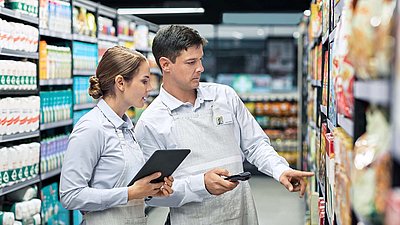Knowing and understanding retail trends and terms
The retail sector is dynamic and innovative – and is constantly coming up with creative solutions and concepts to make shopping experiences even more customer-friendly and appealing. These include digitalization and connectivity ideas such as smart retail and connected retail as well as click and collect, self-checkout, electronic shelf labels, and clienteling. It is not always easy to keep track of all these concepts. We have summarized the most important retail trend terms for you with clear explanations:
|
Terms |
Explanation |
|---|---|
|
Brick and Click |
Combination of physical and digital retail, similar to the concept of connected retail |
|
Click & Collect |
Order products online, then pick them up in the physical store |
|
Clienteling |
Retail strategy for individual and personalized customer service |
|
Connected Retail |
Profitable combination of local and digital retail: Combines the advantages of physical stores (e.g. direct availability, personal advice, multi-sensory shopping through sight, smell, hearing, and touch) with the achievements of digitalization (eCommerce, automation, use of AI, etc.) |
|
eCommerce |
Buying and selling via the Internet |
|
Electronic Shelf Lables (ESL) |
Digital labels that can be updated wirelessly and connected to the merchandise management system |
|
Digital Signage |
Digital display devices (screens, projectors) that present advertising and information |
|
Digital Branch |
Online version of a physical store to purchase products and services on the Internet |
|
Grab & Go |
Retail concept where products are pre-packaged or easily accessible so that customers can quickly select and purchase them without having to queue at a checkout or place an order |
|
Instant Shopping |
Fast, immediate, minimal effort purchase of products or services with the help of one-click ordering, instant payment methods, pre-filled payment / shipping information, and much more |
|
IoT (Internet of Things) in Retail |
Internet-connected objects that communicate with each other and exchange data to improve customer service, increase operational efficiency, and provide a good shopping experience, e.g. smart shelves (inventory control, fast replenishment, theft protection), beacon technology (transmitters placed in the store for personalized offers to customers in the immediate vicinity), analysis / tracking of customer behavior for better product placement, smart checkout systems, wearables for employees, and much more |
|
Live Shopping |
Real-time purchase of products presented via live streams |
|
Mass Customization |
Production of individually customized products or services in large quantities to meet customer needs |
|
Metaverse |
Virtual environment with technologies such as AR (augmented reality) and VR (virtual reality), as well as an interactive platform in which users can interact socially with each other |
|
Microservices Architecture |
Approach in software development in which a large application is divided into smaller, independent services that can be developed, scaled, and provided independently of each other |
|
Mobile Payment |
Contactless payment with mobile devices such as smartphones, smartwatches, special apps, etc.; mostly via NFC |
|
NFC (Near Field Communication) |
Wireless technology that allows devices in close proximity to communicate, for example for contactless payment or data transfer |
|
Omnichannel |
Retail strategy for seamless and consistent experiences across different sales and communication channels, so that customers can have the same shopping experience in both physical and digital commerce |
|
Omnichannel Marketing |
Coordination of marketing activities across various channels and platforms (online, print, social media, in-store, etc.) with seamless integration of advertising, content, and interactions |
|
Omnichannel Retailing |
Flexible combination of physical and digital commerce |
|
Point of Sale (POS) |
Place or time of payment for products or services, in particular in the checkout area |
|
Re-commerce |
Online trade of used products |
|
Retail 4.0 |
Digitalized and networked retail sector with an optimized supply chain, modern technology, and a strong customer focus, through the use of data analysis, virtualization, and new technologies; in line with the term "Industry 4.0" |
|
SCO (Self-Checkout) |
Self-service checkouts where customers scan and pay for products themselves without having to wait at a checkout with cashiers |
|
Seamless Stores |
Seamless shopping experience between physical and digital components and / or online and offline channels, e.g. through Internet of things, artificial intelligence, or augmented reality components, such as interactive displays, advisory services, etc. |
|
Shop & Go |
Fast shopping experiences with the help of self-service checkouts (Scan & Go) or mobile payment options |
|
Shop-in-Shop |
Rented retail space in a larger store in which a retailer / brand presents its own products |
|
Smart Logistics |
More efficient logistics processes thanks to technologies such as AI (artificial intelligence), IoT (Internet of things), and automation |
|
Smart Retail |
Use of intelligent measures and digital tools for the cost-efficient optimization of sales processes, logistics, personnel administration, and customer management in retail, e.g. through technologies (including IoT) and automation |
|
Supply Chain Management (SCM) |
Organization and planning of all steps in a supply chain, i.e. from procurement to delivery |
|
TCO Transparency |
Total cost of ownership: consideration of all costs of a product, including purchase, use, maintenance, and disposal |
All modern retail trends are linked to a lively exchange of data and high-quality Wi-Fi. The new analysis and collaboration technologies and applications can only be used reliably if the IT network provides the appropriate performance and security.
As a German manufacturer of network infrastructures, it is particularly important to us to support retailers in positioning themselves well in terms of NIS2 and digital sovereignty. We would therefore be delighted to provide you with non-binding advice on a high-performance IT network that is ready for all future retail trends.

Wi-Fi 7 designed for Retail
Maximum customer friendliness, innovative shopping technologies, and perfectly harmonized online and offline commerce – retail needs resource-saving, powerful, and intelligent Wi-Fi more than ever.
Wi-Fi 7, in particular, offers retailers unprecedented possibilities and maximum future-proofing. That is why LANCOM has designed its LX-7200 series of Wi-Fi 7 access points specifically to meet the demands of retail. As the formula for the digital retail of the future is: 3x3. But why 3x3?
- Triple Wi-Fi support: Supports the 2.4 GHz, 5 GHz, and exclusive 6 GHz bands for maximum stability.
- Triple ESL manufacturer support: Compatible with VUSION, SoluM, and Hanshow.
- Triple technology support: Features integrated ESL and BLE radio modules, plus the option to connect external USB radio modules.
Discover now the LANCOM LX-7200E - the ideal solution for the digitalized retail business
LANCOM LX-7200E





